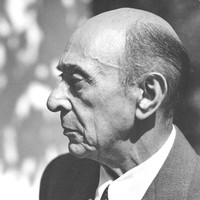Beethoven’s 5th Symphony



Please note: movements performed without pause.
Arnold Schoenberg is most famous — or perhaps infamous — for pioneering atonality and the twelve-tone method of composition. Despite all the “accusations of anarchy and revolution” directed his way over the years, his own view (as he explained in a 1949 lecture) was that his development as a composer “was distinctly evolution, no more exorbitant than that which always has occurred in the history of music.”
In that sense, Schoenberg’s First Chamber Symphony from 1906 is a key link in the ongoing evolution that began when Ludwig van Beethoven unshackled the symphony and string quartet from their tidy confines about a hundred years earlier, a process that continued down one lineage through the taut manipulations of Johannes Brahms, while a parallel lineage led by Richard Wagner, Franz Liszt and Richard Strauss sought the outer limits of the tonal universe.
Schoenberg’s chamber symphony compresses a plan resembling the traditional movements of a symphony into one continuous movement lasting about 20 minutes, moving through sections that he identified as Sonata (Allegro), Scherzo, Development, Adagio, and Recapitulation and Finale. In terms of instrumentation, this score shrinks the expected orchestral forces down to a chamber group of fifteen soloists, but the standard colors of the Classical symphony are still there, with one of each stringed instrument, eight woodwinds and two horns.
In a feat of musical efficiency that recalls Beethoven’s ability to zoom in on a basic gesture, much of Schoenberg’s music concentrates on two basic gestures: chains of perfect fourths (as in the distance between the first two notes in “Here Comes the Bride”), and the whole-tone series, built from equally spaced whole steps. Besides shaping the melodies, those patterns of fourths and whole-tones also stack up vertically, replacing traditional triads as the building blocks for chords.
The First Chamber Symphony was one of Schoenberg’s last works that functioned fully within the realm of tonal harmony, even ending on a sunny major triad. But for all its traditionalism, the sharp elbows of this music revealed an approach its breaking point. As the conductor and Schoenberg expert Robert Craft put it, the chamber symphony was “the densest, most compact and rapidly moving music up to its time,” and it marked a turning point into a different sort of unknown in the years to come.
Aaron Grad ©2022
 Listen to Audio
Listen to Audio
Ludwig van Beethoven made his first sketches for the Fifth Symphony in 1804. He composed the bulk of the symphony in 1807–08 while working concurrently on the Sixth Symphony, and he introduced both works during a four-hour marathon concert in Vienna on December 22, 1808, at which the frigid temperatures and under-rehearsed orchestra made more of an impression than the immortal music heard there for the first time.
The Fifth Symphony comes from the heart of Beethoven’s “middle” period, a phase when his encroaching deafness changed his relationship to composing and performing, and when the elegant classicism of his early works gave way to a more focused and concentrated manner of writing. Rather than issuing flowing melodies, Beethoven’s quintessential works from this period build highly integrated forms out of compact, elemental materials.
The most famous musical nugget Beethoven ever conceived — perhaps the most recognizable motive ever penned by a composer — comes at the start of the Fifth Symphony, when the orchestra delivers four unadorned notes: three short repetitions of G dropping to a sustained E-flat, representing two notes from the home triad of C minor. This one motive fuels the entire first movement based in Beethoven’s favorite key for stormy and fateful music, and traces of it return later in the symphony.
The Andante con moto second movement features a double set of variations, alternating the development of two contrasting themes. Some of the accompanying rhythms echo the short-short-short-long rhythmic pattern from the first movement, contributing to the symphony’s organic cohesion.
The Scherzo retreads the central tonal conflict of the work, juxtaposing a moody first theme in C minor and a spry fugal section in C Major. A coda builds tension that releases directly into the concluding Allegro, which adds piccolo and trombones to the scoring for extra orchestral brilliance. With this grand finale, Beethoven’s Fifth completes its fateful journey to a triumphant resolution in C Major.
Aaron Grad ©2024
Get driving directions and find nearby parking.
Find dining options close to the venue.
View seating charts to find out where you'll be seating.
SPCO concerts are made possible by audience contributions.
For exclusive discounts, behind-the-scenes info, and more:
Sign up for our email club!
